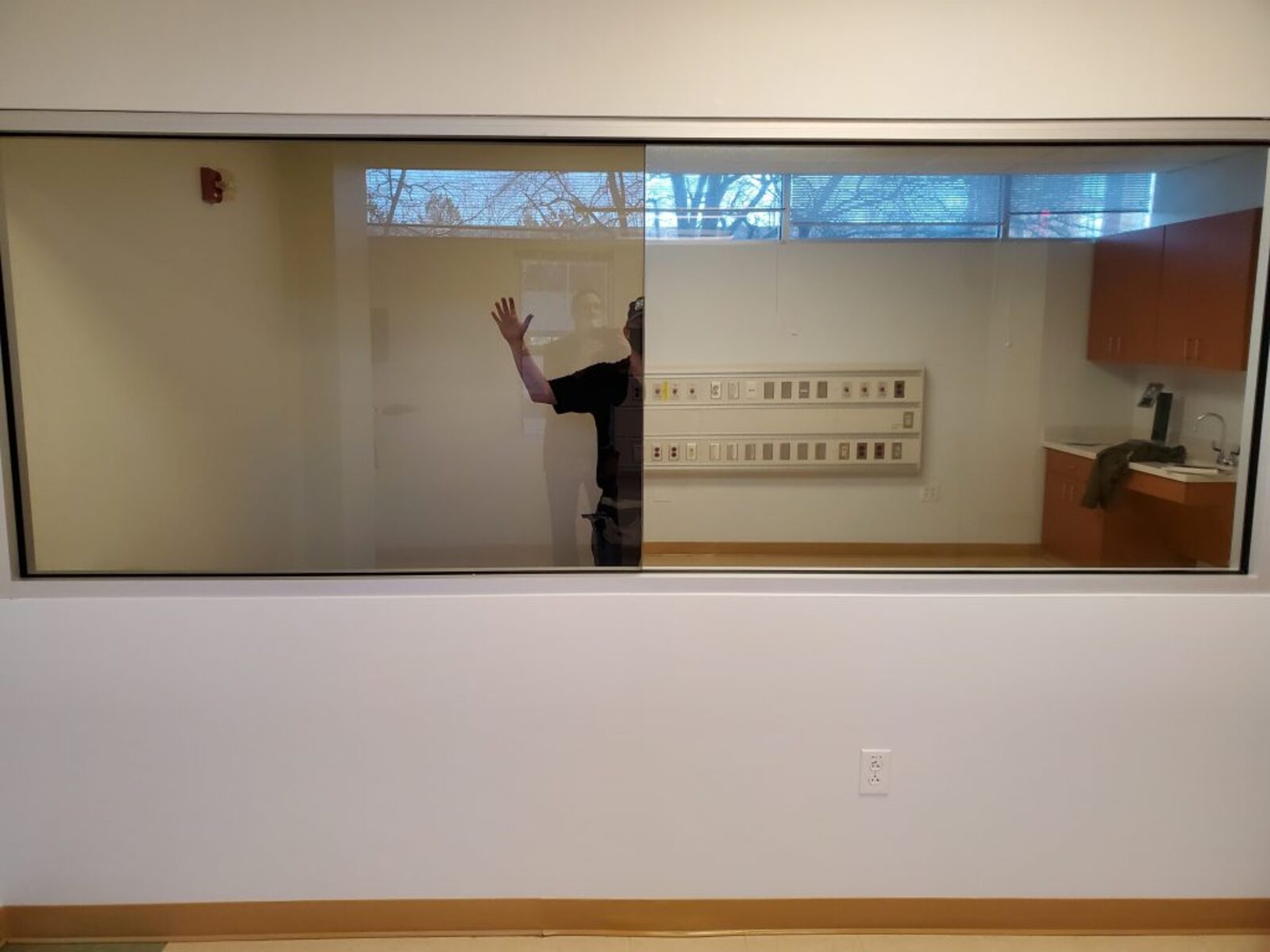What is a One-Way Mirror?
A one-way mirror, also known as a two-way mirror or semi-transparent mirror, is a special type of glass that allows light to pass through and reflects a certain amount of light, creating a mirror-like appearance. The unique feature of a one-way mirror is that it allows people on one side to see through it, while those on the other side see only their reflection. This creates the illusion of a mirror from one side and transparency from the other side.
One-way mirrors are commonly used in areas where privacy is desired, such as interrogation rooms, surveillance rooms, and observation decks. They play a crucial role in maintaining confidentiality and allowing for discreet monitoring of activities.
The concept of a one-way mirror is based on the principle of differential light transmission. It involves the manipulation of light reflection and transmission properties to achieve the desired effect. The glass used in a one-way mirror is typically coated with a thin layer of reflective material, such as aluminum, that allows some light to pass through while reflecting the rest.
It is important to note that the functionality of a one-way mirror is dependent on the lighting conditions on both sides. For example, during the daytime, when the lighting on the observation side is brighter than the illuminated side, the mirror effect is more pronounced. However, in low-light conditions, such as at night, the effectiveness of the one-way mirror may decrease, and the transparency of the glass may be compromised.
Now that we have established what a one-way mirror is, let’s explore how it works and the underlying physics behind this fascinating optical phenomenon.
How Does a One-Way Mirror Work?
A one-way mirror works by exploiting the principles of light reflection, transmission, and absorption. It is designed to allow for differential light transmission, where light is selectively transmitted and reflected depending on the intensity of the light on either side of the mirror.
The key factor in the functionality of a one-way mirror is the difference in lighting conditions between the two sides. When one side of the mirror is brightly lit, while the other side is relatively darker, the mirror effect is achieved. The brighter side acts as the observer side, while the darker side acts as the observed side.
From the observer’s side, the reflective coating on the mirror reflects most of the light that strikes it, creating a mirrored appearance. This is because the bright light on the observer side overpowers the light coming from the other side, making it difficult to see through. However, a small portion of the light is transmitted through the mirror, allowing for some visibility. This is why it is called a one-way mirror, as one side has a reflective effect, while the other side has partial transparency.
On the observed side, the lighting conditions are relatively darker. The light that strikes the surface is absorbed or transmitted through the mirror, resulting in limited reflection. As a result, people on this side can see through the glass, perceiving it as transparent.
The effectiveness of a one-way mirror also depends on the angle of incidence of the light. When the angle is small, more light is reflected, enhancing the mirror effect. However, as the angle increases, the amount of light reflected decreases, leading to increased visibility through the mirror.
It is interesting to note that the perception of a one-way mirror is not foolproof, as it relies on the difference in lighting conditions. In certain scenarios, such as when the lighting is balanced on both sides or when the observer is very close to the mirror, the one-way effect may diminish, and both sides may be able to see each other.
Now that we understand how a one-way mirror works, let’s delve into the physics behind this intriguing phenomenon.
Understanding the Physics Behind One-Way Mirrors
The physics behind one-way mirrors involves the principles of light reflection, transmission, and absorption. To understand this optical phenomenon, we need to explore some key concepts in physics.
One of the fundamental principles at play is the behavior of light when it strikes a surface. When light encounters a surface, it can either be reflected, transmitted, or absorbed. The interaction between light and the surface depends on various factors, including the angle of incidence, the refractive index of the materials involved, and the nature of the surface itself.
In the case of a one-way mirror, the glass used has a special coating, often a thin layer of metal, such as aluminum. This coating is applied to one side of the glass during the manufacturing process. The metal coating serves two purposes: reflection and transparency control.
When light from the observer side of the mirror strikes the metal coating, the majority of the light is reflected. This creates the mirrored appearance, as most of the observer’s light is reflected back towards them. The metal coating acts as a barrier, preventing the light from passing through the glass.
However, a small portion of the light is transmitted through the metal coating, allowing for limited visibility from the observer side. This occurs because the metal coating is not perfectly opaque; it allows some light to pass through, albeit at a reduced intensity.
On the observed side of the mirror, the lighting conditions are dimmer compared to the observer side. Consequently, the amount of light that strikes the metal coating is significantly reduced. The metal coating is designed to absorb or transmit this lower intensity of light, rather than reflecting it back. As a result, people on the observed side can see through the glass, perceiving it as transparent.
The angle of incidence of the light also plays a significant role in determining the functionality of a one-way mirror. When the angle of incidence is small, more light is reflected back towards the observer side, enhancing the mirror effect and making it difficult to see through. Conversely, as the angle of incidence increases, the amount of reflected light decreases, leading to increased visibility through the mirror.
The behavior of one-way mirrors is also influenced by the lighting conditions on both sides. For optimal mirror effect, the observer side should be significantly brighter than the observed side. When the lighting conditions on both sides are similar or when the observer is very close to the mirror, the one-way effect may diminish, and both sides may be able to see each other.
By understanding the physics behind one-way mirrors, we can appreciate the intricacies of this optical phenomenon. Next, let’s explore the factors that can affect the effectiveness of a one-way mirror.
Factors Affecting One-Way Mirror Effectiveness
The effectiveness of a one-way mirror can be influenced by various factors. Understanding these factors is crucial in determining the optimal conditions for achieving the desired mirror effect or transparency. Let’s explore some key factors that can affect the effectiveness of a one-way mirror:
1. Lighting Conditions: The lighting conditions on both the observer and observed sides play a significant role in the effectiveness of a one-way mirror. For the mirror effect to be pronounced, the observer side should be considerably brighter than the observed side. This ensures that the majority of the light is reflected back towards the observer, creating the mirrored appearance. In low-light conditions, the mirror effect may be diminished, and the glass may appear more transparent.
2. Angle of Incidence: The angle at which light strikes the one-way mirror surface affects its reflectivity. When the angle of incidence is small, more light is reflected, enhancing the mirror effect. However, as the angle increases, the amount of reflected light decreases, resulting in increased visibility through the mirror. This means that the mirror effect may be more prominent when viewing the mirror head-on, and less noticeable when viewing it from an angle.
3. Reflective Coating Quality: The quality and thickness of the reflective coating applied to the glass can affect the mirror effect. A high-quality and well-applied reflective coating can maximize reflection and minimize transmission, leading to a more pronounced mirror appearance. Inferior or uneven coatings may result in reduced mirror effect and compromised transparency.
4. Distance from the Mirror: The distance between the observer and the one-way mirror can impact the perception of the mirror effect. When standing close to the mirror, the observer may have a clearer view through the glass, especially if the lighting conditions are similar on both sides. By increasing the distance, the mirror effect can be more pronounced.
5. Environmental Factors: Environmental factors such as ambient lighting, background colors, and reflections can also influence the effectiveness of a one-way mirror. Bright or contrasting background colors on the observer side can enhance the mirror effect, while similar colors on both sides may reduce it. Additionally, external light sources, such as windows or artificial lighting, can impact the perceived transparency of the mirror.
It is important to note that the effectiveness of a one-way mirror is not absolute and can vary depending on the specific conditions. Different combinations of lighting, angles, and reflective coatings can result in varying degrees of mirror effect and transparency.
By considering these factors, it is possible to utilize one-way mirrors effectively in various applications, such as surveillance, interrogation rooms, or observation decks.
Testing a One-Way Mirror
Testing a one-way mirror is essential to ensure its effectiveness and functionality. By conducting proper tests, one can determine if a mirror is truly one-way or if it may have compromised reflective or transparency properties. Here are some methods to test a one-way mirror:
1. Lighting Test: The lighting test involves creating a significant contrast in lighting conditions between the two sides of the mirror. Place the mirror in an area where one side is well-lit and the other side is relatively darker. Observe from the brighter side to see if the mirror reflects your image and limits visibility from the darker side. Then, move to the darker side to determine if you can see through the mirror. If the mirror fulfills these criteria, it indicates that it is functioning as a one-way mirror.
2. Angle Test: The angle test examines the mirror from various viewing angles. Stand at different angles in relation to the mirror and observe the reflected image. Notice if the mirror effect is more pronounced when viewing the mirror head-on compared to when viewing it from an angle. If the mirror maintains a strong mirror effect when viewed head-on but becomes more transparent when viewed from an angle, it suggests it is a one-way mirror.
3. Tap Test: The tap test involves lightly tapping the surface of the mirror and observing the resulting vibrations. When you tap a one-way mirror, it should produce a clear, hollow sound. This indicates that there is a gap between the glass and the reflective coating. If there is no gap and the sound is dampened or muffled, it may suggest that the mirror is not a true one-way mirror.
4. Observational Test: The observational test involves having someone on the observed side of the mirror while another person stands on the observer side. The person on the observer side should observe the reflection of the person on the observed side and check if their image is clearly reflected, while the person on the observed side checks if they can see through the mirror. This test helps validate the one-way properties of the mirror.
5. Professional Assessment: For more accurate and comprehensive testing, it may be beneficial to consult with professionals who specialize in glass and mirror technologies. They have the knowledge and equipment to conduct thorough assessments of one-way mirrors, including measuring light transmission and reflectivity.
By conducting these tests, it is possible to ensure that a mirror is indeed a one-way mirror, providing the desired effects of privacy and observation. It is essential to regularly test and maintain one-way mirrors to ensure their ongoing functionality and effectiveness in various applications.
Different Uses of One-Way Mirrors
One-way mirrors have a wide range of practical applications across various industries. Their unique properties make them valuable in situations where observation, surveillance, and privacy are required. Here are some of the different uses of one-way mirrors:
1. Interrogation Rooms: One-way mirrors are commonly used in law enforcement and intelligence agencies during interrogations. The suspect is seated in a room with a one-way mirror, while investigators observe their behavior and reactions from the other side. This setup allows for discreet monitoring without the suspect being aware of being observed, facilitating more effective investigations.
2. Surveillance Rooms: One-way mirrors are integral to surveillance rooms in security and monitoring settings. These mirrors enable security personnel to monitor specific areas without alerting potential intruders or suspicious individuals to their presence. The one-way mirror allows for covert surveillance, providing valuable insights without compromising safety.
3. Observation Decks and Control Rooms: One-way mirrors are often utilized in observation decks and control rooms, such as in zoos, museums, and scientific research facilities. Visitors can observe animals, exhibits, or ongoing experiments without disturbing the subjects or compromising the natural behavior being studied. The one-way mirror acts as a barrier between the observer and the observed, ensuring minimal interference.
4. Two-Way Communication: In some cases, one-way mirrors are used to facilitate two-way communication in controlled environments. For instance, in auditions or interview rooms, the interviewer can observe the auditionees or interviewees through the mirror while maintaining privacy. This allows for better assessment and decision-making without the candidates feeling directly scrutinized.
5. Theatrical Performances and Film Sets: In the entertainment industry, one-way mirrors are used during live performances and on film sets. They enable directors and stage managers to observe the actors without being seen or disrupting the performance. This allows for real-time adjustments and improvements to the production without distractions.
6. Privacy in Public Spaces: One-way mirrors can be employed in public spaces, such as restrooms and fitting rooms, to provide privacy while still ensuring safety and security. By allowing individuals inside to see out while appearing as a mirror from the outside, it helps create a sense of privacy and comfort in public settings.
7. Smart Homes: With the advancements in home automation technology, one-way mirrors are used in smart homes to integrate privacy and convenience. For example, bathrooms equipped with one-way mirrors can transform into private spaces at the touch of a button, providing transparency or creating a mirrored appearance as needed.
The versatile nature of one-way mirrors makes them invaluable in numerous settings. Whether for security, observation, or privacy purposes, one-way mirrors offer practical solutions for a wide range of industries and environments.
How to Tell if a Mirror is One-Way or Two-Way
Determining whether a mirror is one-way or two-way can be challenging at first glance. However, there are several methods you can use to differentiate between the two. Here are some ways to tell if a mirror is one-way or two-way:
1. Lighting Assessment: Stand on both sides of the mirror and observe the lighting conditions. In a one-way mirror, there will be a noticeable difference in lighting between the two sides. The observer side will typically be brighter, while the observed side will appear darker. A two-way mirror, on the other hand, will have more consistent lighting conditions on both sides.
2. Reflective Test: Place a finger or a small object against the mirror’s surface. If the reflection of your finger or the object appears to touch or overlap with the actual object, it is likely a two-way mirror. In a one-way mirror, the reflection will be slightly set back from the actual object, creating a distinct gap between the two images.
3. Viewing Angle: Change your viewing angle when standing in front of the mirror. In a one-way mirror, the reflection of your face or body will be more visible head-on, with the mirror effect becoming less pronounced as you move to the side. A two-way mirror will maintain a consistent reflection regardless of the viewing angle.
4. Lighting Test: Turn off the lights in the room and use a bright flashlight to shine on the mirror from different angles. If the light passes through the mirror, it is likely one-way, as it allows some light transmission. A two-way mirror will reflect most of the light back.
5. Observation Test: Observe the behavior of people on the other side of the mirror. If they appear aware of your presence or make eye contact with you, it is likely a two-way mirror. A one-way mirror should create a sense of privacy, with individuals on the observed side unaware of being observed.
It is important to note that these methods are not foolproof and may have limitations in certain situations. Different types of one-way and two-way mirrors can vary in their construction and functionality. If you are uncertain or require absolute confirmation, it is advisable to seek professional assistance or consult with experts who specialize in glass and mirror technologies.
By employing these techniques, you can gain a better understanding of whether a mirror is one-way or two-way and make informed judgments based on your observations.
Tips for Identifying One-Way Mirrors in Different Settings
Identifying one-way mirrors in different settings can be challenging, especially when you are not familiar with their specific characteristics. Here are some tips to help you identify one-way mirrors in various settings:
1. Lighting Discrepancy: Observe the lighting conditions on both sides of the mirror. A one-way mirror will typically exhibit a noticeable difference in lighting between the observer and observed sides. The observer side tends to be brighter, while the observed side appears darker. This lighting discrepancy is one of the key indicators of a one-way mirror.
2. Distance and Angle: Move closer to the mirror and vary your viewing angles. A true one-way mirror will exhibit a stronger mirror effect when viewed straight on, with the reflection of your face or body being more prominent. As you move to the side or change angles, the mirror effect should diminish, and you should be able to see through the glass to some extent.
3. Observation Behavior: Pay attention to how people on the other side of the mirror interact or behave. If individuals on the observed side seem unaware of being observed or show no reaction to your presence, it suggests that the mirror is likely one-way. In contrast, a two-way mirror may result in individuals being more aware of being observed and potentially making eye contact with you.
4. Tap Test: Gently tap the surface of the mirror and observe the resulting sound. One-way mirrors typically have a small gap between the glass and the reflective coating, producing a hollow or distinctive sound when tapped. In contrast, a two-way mirror may produce a dull sound without that distinct hollow quality.
5. Professional Consultation: If you need to be absolutely certain about the nature of a mirror, it is advisable to seek professional consultation. Experts specializing in glass and mirror technologies can provide accurate assessments and determine if a mirror is truly a one-way mirror.
Remember that the effectiveness of one-way mirrors can vary depending on the specific lighting conditions, angles, and quality of the mirror itself. It is essential to consider multiple factors and use a combination of these tips to make a more accurate judgment.
Being able to identify one-way mirrors in different settings can help you better understand when your privacy may be compromised or when you are being discreetly observed. This knowledge allows you to make informed decisions and adjustments to ensure your privacy and security.
The Ethical Considerations of One-Way Mirrors
The use of one-way mirrors raises important ethical considerations due to their potential impact on privacy and consent. While they serve practical purposes in certain contexts, it is essential to evaluate the ethical implications associated with their use. Here are some key ethical considerations regarding one-way mirrors:
1. Privacy Invasion: One-way mirrors can be perceived as an intrusion into personal privacy. Being observed without consent can create feelings of discomfort, violation, and a lack of control over one’s personal space. It is crucial to balance the need for observation or surveillance with respect for individual privacy rights.
2. Informed Consent: In situations where one-way mirrors are used for observation or monitoring, obtaining informed consent becomes essential. The individuals being observed should be aware that they may be subject to surveillance or scrutiny. Transparency and clear communication regarding the presence of one-way mirrors can help ensure informed consent and mitigate potential privacy concerns.
3. Trust and Integrity: The use of one-way mirrors can impact the trust and integrity of relationships. Employers, for example, should communicate openly with employees regarding the presence of one-way mirrors in the workplace. Failure to do so may result in a breach of trust and a negative impact on employee morale and well-being.
4. Contextual Consideration: Consider the specific context and purpose for which the one-way mirrors are being used. It is important to assess whether the observation or surveillance serves a legitimate purpose, such as security, safety, or research. Understanding the potential benefits and weighing them against the potential privacy concerns helps determine the ethical appropriateness of using one-way mirrors.
5. Legal Compliance: Ensure that the use of one-way mirrors complies with relevant laws and regulations concerning privacy, surveillance, and consent. Different regions have specific laws governing the use of surveillance devices and privacy rights. It is crucial to familiarize yourself with these laws and ensure compliance to avoid legal implications.
6. Proportional Use: Consider whether the use of one-way mirrors is proportionate to the intended purpose. The level of surveillance or observation should be justified and necessary, without infringing upon the reasonable expectations of privacy individuals have in certain settings.
7. Regular Assessment: Continuously evaluate the use of one-way mirrors to ensure ongoing ethical compliance. Monitor and review their use periodically, taking into account changing circumstances or evolving societal norms.
By carefully considering the ethical implications associated with one-way mirrors, it is possible to strike a balance between the need for observation and privacy rights. Transparency, informed consent, and respect for personal boundaries play pivotal roles in navigating the ethical considerations surrounding the use of this technology.





